| EQUINETOURISM - HORSE BREEDS - The Shetland Pony |
| British Native Pony Breeds - The Shetland Pony |
Today the Shetland pony no longer has the hardworking life of it’s ancestors, as nowadays the main employment is for a child’s riding pony or for carriage driving, and it is hugely popular world-wide.
|
|
|
| The Shetland Pony Breed |
Small ponies have existed in the Shetland Isles for over 2000 years and probably much longer. Various excavations on the islands have revealed the bones of small ponies that existed during the Bronze Age and it is thought that ponies have been in domestic use there since this time.
It is believed that the Shetland has its origin in the Cob type of Tundra and the Mountain Pony type from Southern Europe which migrated via the ice fields and land masses, with later introduction of a pony brought to the islands by the Celtic people which had evolved from crossing the same Mountain Pony type with the Oriental horse. Due to its island existence the pony has evolved with relatively few importations and those that did arrive were by necessity small owing to the difficulties of transportation by sea.
Two significant types established themselves within the breed, the heavier boned animal with a longer head and the lighter one with high tail carriage and small pretty head, and these have remained distinct characteristics which has stood the pony in very good stead for its changing roles in the service of mankind.
Surviving Harsh Climates: Over the centuries various reports and descriptions of the pony refer to its small stature, strength, hardiness and long levity. The harsh winters of the Islands with little feed due not to the neglect of owners but to the difficulties of available fodder for even their sheep and cattle is surely the reason for the hardiness and purity of the breed, only the toughest surviving successive winters to breed. No place in Shetland is further than four miles from the sea and it is legendary that during the worst winters lack of grazing on the scathold would drive some ponies to forage for seaweed along the shores. The ponies however were not small due to sparse living conditions but rather it was the small pony that was able to survive this, whereas larger horses did not. Shetlands bred in milder climates which are given ample food do not increase in size at all.
Working Ponies: Various stories about the ponies strength are legendary - for their size they are the strongest of all the horse breeds. For centuries the pony cultivated the land, carried the peat from the scatholds and seaweed for the fields, and was used to transport his owner. The pony was never a draught animal until the mid 19th century as there were no proper roads until then. The horse owning fisherman was able to use hair from the ponies tails for his lines.
Shetlands as Pit Ponies: When the law in 1847 banned children from entering the coal pits, the Shetland pony colts became in great demand and many had to exchange the freedom of the hills for the darkness of the mines. In fact their docile and willing nature enabled them to adapt very well to their underground environment and they were treated with much affection by their handlers and every so often they were returned to above ground for a period of time. At this time, several studs were formed in an attempt to improve the stock by the use of the best stallions available that would breed ponies with the bone and substance necessary for the pit trade.
Riding & Driving Ponies: The breed also attracted much interest for children to ride and for driving and many people, including Queen Victoria, owned several pairs of Shetlands for drawing their smart phaetons. In the last twenty years of the nineteenth century thousands of ponies left the islands, reports of over one thousand a year, and many were exported across the Atlantic.
Establishing the Shetland Pony Stud-Book Society: During this period of huge popularity the Shetland Pony Stud-Book Society was formed in 1890 with the aim of publishing a Stud Book which was the first for a native breed of pony in Britain. Many of the registered ponies today can trace their pedigrees back to the first volumes of the Stud Book and we owe much to the skill and dedication of the owners of these early studs in selecting the best ponies from the unregistered stock available to them. Most notable of these was the Marquis of Londonderry’s stud which was formed in the 1870’s on the islands of Bressay and Noss to supply ponies for the collieries he owned in County Durham. By careful selection of stock he produced a much improved animal in a remarkably short time and these ponies had the most significant effect on the type of ponies we have today. Ponies with the best conformation available were acquired and the stallions closely bred to, the most famous being Jack 16 who had 49 direct descendants out of the 58 mares entered in Volumes I and II of the Stud Book. The stud was dispersed in 1899 and but most of the main breeders of this time acquired stock from this Stud including the Ladies Hope who brought ponies south to their home in Sussex where they bred with great success and the stud continues today. They kept only the best of their ponies for breeding and when certain the type was true they also bred close. They had the most Londonderry blood of any in their stock and many breeders acquired stock from them with the result that numerous ponies of today trace back to the Bressay stud through the Hope lines.
THE SHETLAND PONY TODAY
Today the Shetland pony no longer has the hardworking life of it’s ancestors, as nowadays the main employment is for a child’s riding pony or for carriage driving, and it is hugely popular world-wide. The two types established within the breed from the ponies origins and which remain distinct characteristics today make it highly suitable for either function, the heavier boned draught animal with powerful chest and shoulders for driving and the lighter free moving pony with high tail carriage and pretty head for riding.
It is to the credit of breeders past and present that these two types have been successfully combined and yet may still retain a certain difference which has given us the versatile ponies that we have today. Their temperament is superb for both riding and driving but it is essential that even though they are small they are broken in exactly the same way as for larger equines, being long reined, mouthed and backed.
Their docile nature is ideal for a child’s first pony and they can hold their own amongst much larger ponies. They are driving ponies par excellence given their high intelligence and courageous disposition and for their size they are the strongest of all the horse breeds.
The height limit for adult ponies is 42" - ponies upwards of 34‚ÄĚ are ‚ÄėStandards‚Äô and ponies up to 34‚ÄĚ are ‚ÄėMiniatures‚Äô. Both should have the same characteristics and comply with the Breed Standard on all points. Ponies as small as 26‚ÄĚ have been recorded centuries ago in the islands which were just as hardy and thrifty as their larger relations but breeders are not encouraged to breed too small and the popular height for miniatures in the show ring is around 32‚ÄĚ.
Official Society sales of ponies are held in various locations in the UK each Spring and Autumn with buyers coming from all over the world to purchase ponies bred in the mother country. A number of Shetland Pony Groups have been formed throughout the UK and these hold Group Shows and other events in their localities during the year.
 
|



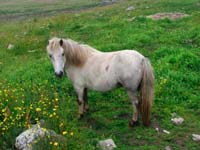
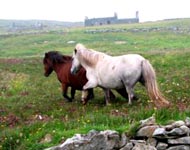

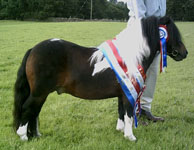

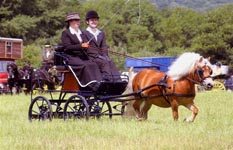
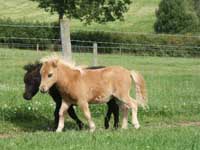

|
| The Shetland Breed Standard |
The UK Shetland Pony Stud-Book Society sets the breed standard for registered Shetland ponies world-wide.
Height - Registered stock must not exceed 42 inches (107cms) at four years or over.
Colour - Shetland ponies may be any colour known in horses except spotted.
Coat - A double coat in winter with guard hairs which shed the rain and keep the pony's skin completely dry in the worst of the weather and, in summer a short coat which should carry a beautiful silky sheen. At all times the mane and tail hair should be long, straight and profuse.
Head - The head should be small, and in proportion. Ears should be small and erect, wide set but pointing well forward. Forehead should be broad with bold, dark, intelligent eyes. Muzzle must be broad with nostrils wide and open. Teeth and jaw must be correct.
Body - The neck should be properly set onto the shoulder, which in turn should be sloping, not upright, and end in a well defined wither. The body should be strong, with plenty of heart room, well sprung ribs, the loin strong and muscular. The quarters should be broad and long with the tail set well up on them.
Forelegs - These should have good, flat bone. Strong forearm. Short balanced cannon bone. Springy pasterns.
Hindlegs - The thighs should be strong and muscular with well-shaped strong hocks. When viewed from behind, the hindlegs should not be set too widely apart, nor should the hocks be turned in.
Feet - Tough, round and well shaped.
Action - Straight, free action using every joint. Tracking up well.
General - A most salient and essential feature of the Shetland pony is its general air of vitality (presence), stamina and robustness. |
| For More information |
| The Shetland Pony Stud-Book Society
Registered Office:
Shetland House, 22 York Place, Perth. PH2 8EH
Tel 00 44 (0)1738 623471
Fax: 00 44 (0)1738 442274
email [email protected]
www.shetlandponystudbooksociety.co.uk
Registered as a Charity in Scotland No. SCO14784
Photography supplied with kind permission of The Shetland Pony Stud-Book Society
|
| How to advertise your Stud, Equestrian Centre, Horse Holiday, Events & Shows & Training etc |
| PLEASE CLICK HERE TO ADVERTISE |
BACK TO EQUINETOURISM.CO.UK WORLDWIDE HORSE HOLIDAYS FRONT PAGE
|
|
  Horse riding holidays, equestrian events and shows, horseback vacations, equine directory, good horsemanship, horse holidays, uk and worldwide
 
ADVERTISE on Equinetourism.co.uk - Click here
SEARCH FOR CONTENT ON EQUINETOURISM.CO.UK |
Also see www.EquineTourismCommunity.com and www.EquineTourism.com
email: [email protected] - Telephone 00 44 (0)1643 862785
www.EquineTourism.co.uk is owned by Happy Horses Ltd, Holt Ball, Luccombe, Minehead, Exmoor, Somerset TA24 8SZ
Full worldwide copyright and all rights retained ©2004-2014 ongoing Happy Horses Ltd. Please read our Disclaimer
|
